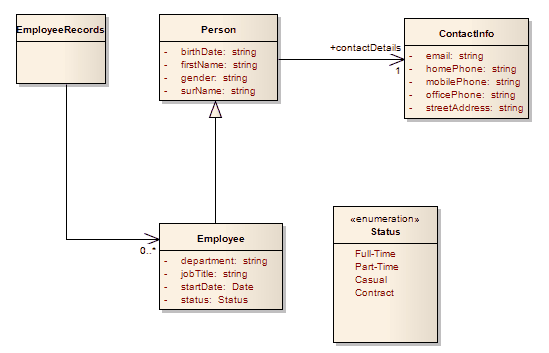| 前页 | 后页 |
来自抽象类模型的 XML
您可以仅使用简单的抽象类模型来建模 XML 模式。例如,这使得架构师可以开始在更高的抽象级别上工作,而无需关心架构的实现细节。虽然这种抽象模型随后可以使用工具箱的“ XML Schema ”页面进行工具箱,但也可以直接由Enterprise Architect的架构生成器生成,在这种情况下,架构生成器应用一组默认映射来转换将抽象模型转换为 XSD 文件。
示例
结构 |
细节 |
|---|---|
|
图表 |
这是早期员工详细信息示例模型的简单类元素版本。它不使用 XSD 特定的刻板印象或标记值。 |
|
架构 |
该模式片段可以从示例模型中生成: <?xml 版本=" 1 .0"?> <xs:schema xmlns:xs="http://www.w3.org/2001/XMLSchema"> <xs:simpleType name="状态"> <xs:restriction base="xs: string "> <xs:enumeration value="全职"/> <xs:enumeration value="兼职"/> <xs:enumeration value="休闲"/> <xs:enumeration value="合约"/> </xs:限制> </xs:simpleType> <xs:元素名称=" Person " type=" Person "/> <xs:complexType name=" Person "> <xs:序列> <xs:元素名="firstName" type="xs: string "/> <xs:元素名="surName" type="xs: string "/> <xs:元素名="birthDate" type="xs: string "/> <xs:元素名="gender" type="xs: string "/> <xs:元素="contactDetails" type="ContactInfo"/> </xs:sequence> </xs:complexType> <xs:元素名称="Employee" type="Employee"/> <xs:complexType name="员工"> <xs:复杂内容> <xs:extension base=" Person "> <xs:序列> <xs:元素名称="状态" type="状态"/> <xs:元素名="jobTitle" type="xs: string "/> <xs:元素名称="startDate" type="xs:date"/> <xs:元素名="department" type="xs: string "/> </xs:sequence> </xs:extension> </xs:complexContent> </xs:complexType> <xs:元素名称="EmployeeRecords" type="EmployeeRecords"/> <xs:complexType name="EmployeeRecords"> <xs:序列> <xs:元素="Employee" type="Employee" minOccurs="0" maxOccurs="unbounded"/> </xs:sequence> </xs:complexType> <xs:元素名称="ContactInfo" type="ContactInfo"/> <xs:complexType name="ContactInfo"> <xs:序列> <xs:元素名="homePhone" type="xs: string "/> <xs:元素名="mobilePhone" type="xs: string "/> <xs:元素名="officePhone" type="xs: string "/> <xs:元素名="email" type="xs: string "/> <xs:元素名="streetAddress" type="xs: string "/> </xs:sequence> </xs:complexType> </xs:schema> |


